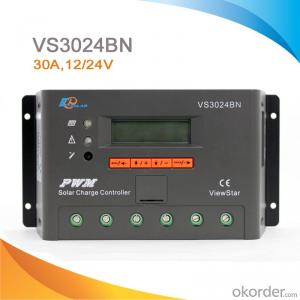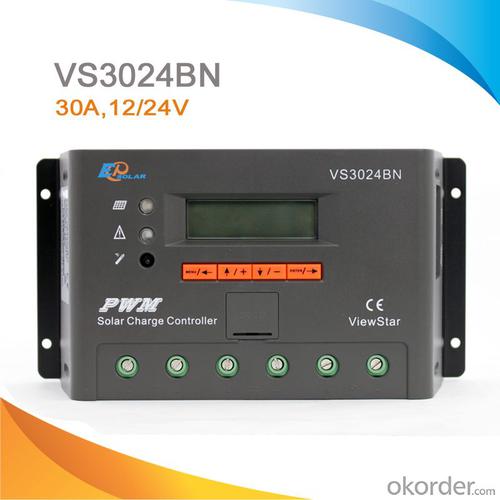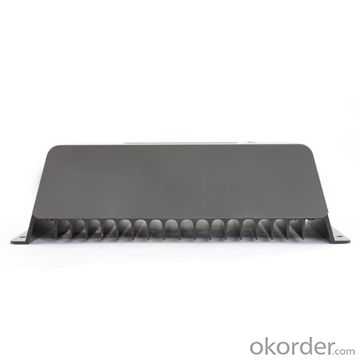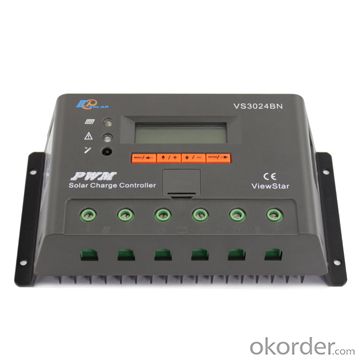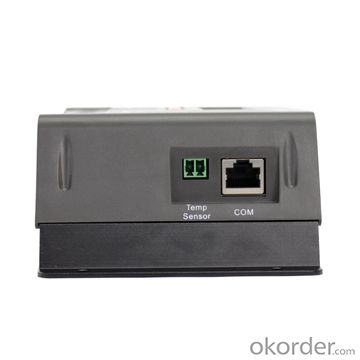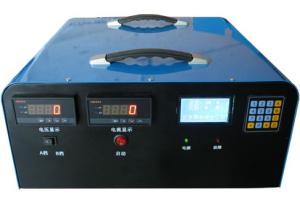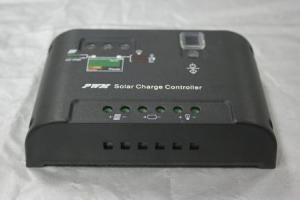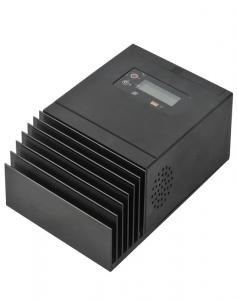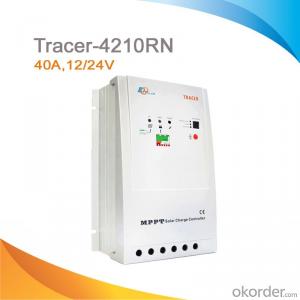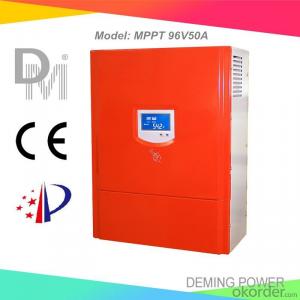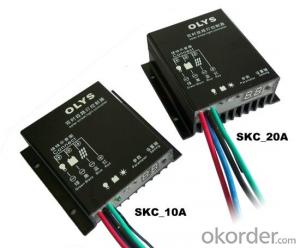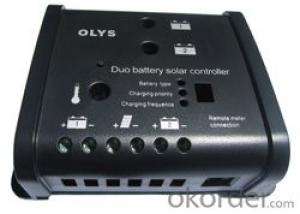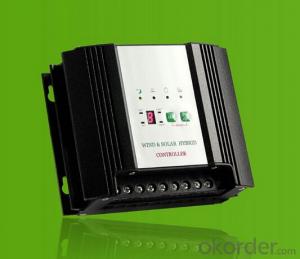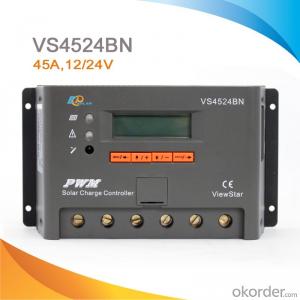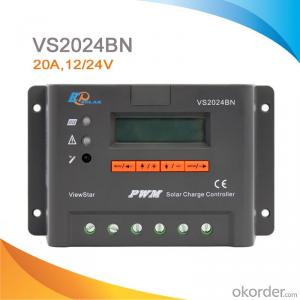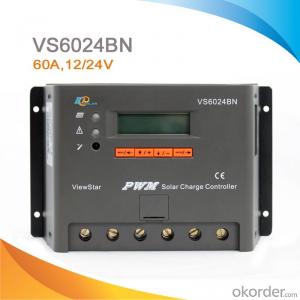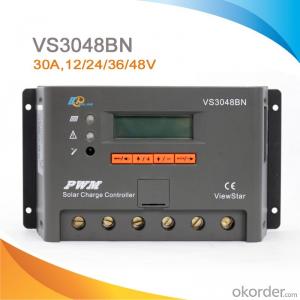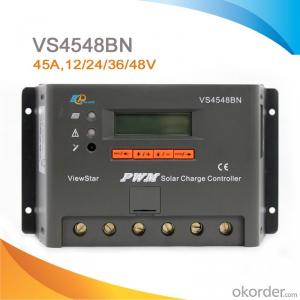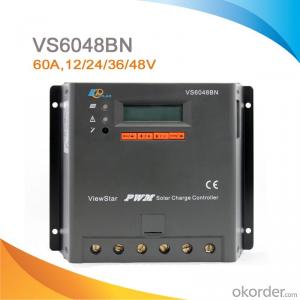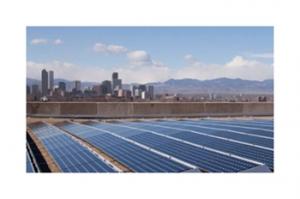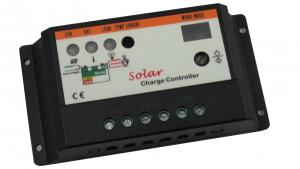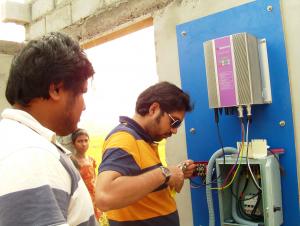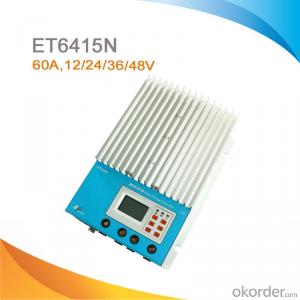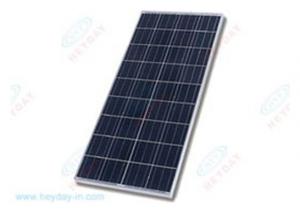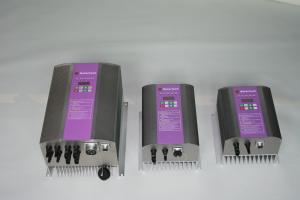Rv Solar Controllers - LCD/LED High Quality PWM Solar Panel Charge Controller/Regulator with CE ROHS, 30A 12V/24V, VS3024BN
OKorder Service Pledge
OKorder Financial Service
You Might Also Like
Features:
·Excellent EMC design
·32 bit MCU with high speed
·High efficient Series PWM charging
·Four battery type options: Sealed, Gel, Flooded, and USER
·Intelligent lighting and timer control for solar lighting system
·12 bit A/D high-precision sampling to ensure accuracy
·Use MOSFET as electronic switch
·Full control parameters setting and modification, diversified load control mode
·Humanized design of browser interface, undertake every operating conveniently
·Temperature compensation
·Adopt graphics dot-matrix LCD screen and HMI (human-machine interface) with 4 buttons,integrated menu displaying and operation
·Energy statistics function
·RS485 ports with MODBUS communication protocol
·Optional PC monitoring software and remote meter for real-time monitoring and battery management parameter setting
·Field upgradable firmware
Electronic Protections:
·PV short circuit protection
·PV reverse polarity protection
·Battery overcharge protection
·Battery over discharge protection
·Battery reverse polarity protection
·Load overload protection
·Load short circuit protection
·Overheating protection
Specification:
Model | VS1024BN | VS2024BN | VS3024BN | VS4524BN | VS6024BN |
Nominal system voltage | 12V/24V auto work | ||||
Rated battery current | 10A | 20A | 30A | 45A | 60A |
Rated load current | 10A | 20A | 30A | 45A | 60A |
Max. battery voltage | 32V | ||||
Equalize charging voltage | Sealed: 14.6V, Flooded: 14.8V, User-defined: 9~17V | ||||
Boost charging voltage | Gel: 14.2V, Sealed: 14.6V, Flooded: 14.8V, User-defined: 9~17V | ||||
Float charging voltage | Gel /Sealed /Flooded: 13.8V, User-defined: 9~17V | ||||
Low voltage reconnect voltage | Gel /Sealed /Flooded: 12.6V, User-defined: 9~17V | ||||
Low voltage disconnect voltage | Gel /Sealed /Flooded: 11.1V, User-defined: 9~17V | ||||
Self-consumption | ≤15mA(12V); ≤10mA(24V); ≤9mA(36V); ≤8mA(48V) | ||||
Grounding | Common negative | ||||
Temp. compensation | -3mV/°C/2V | ||||
Relative humidity | 10%~90% Non-condensation | ||||
Communication | RS485 / RJ45 interface | ||||
LCD temperature | -20°C ~ +70°C | ||||
Working temperature | -25°C ~ +55°C | ||||
Humidity | ≤95% N.C. | ||||
Enclosure | IP30 | ||||
Overall dimension | 162x85x40mm | 162x100x50mm | 200x103x58mm | 201x109x59mm | 205x129x67mm |
Terminals | 4mm2 | 10mm2 | 16mm2 | 35mm2 | 35mm2 |
Net weight | 0.2kg | 0.4kg | 0.7kg | 0.9kg | 1.3kg |
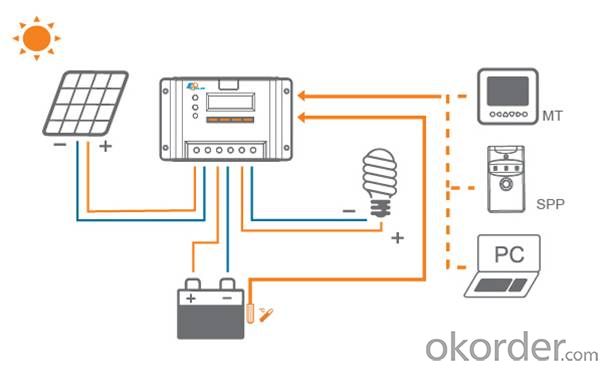
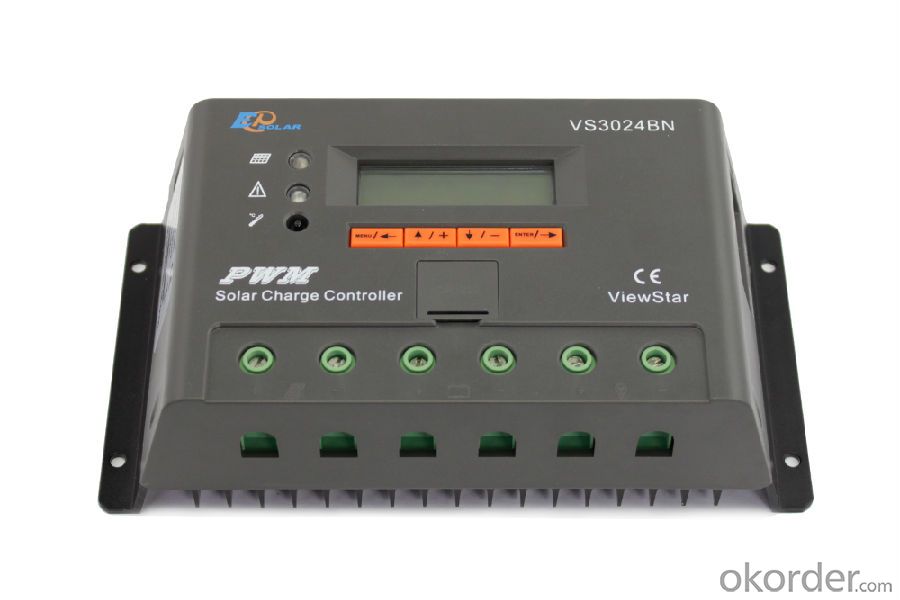
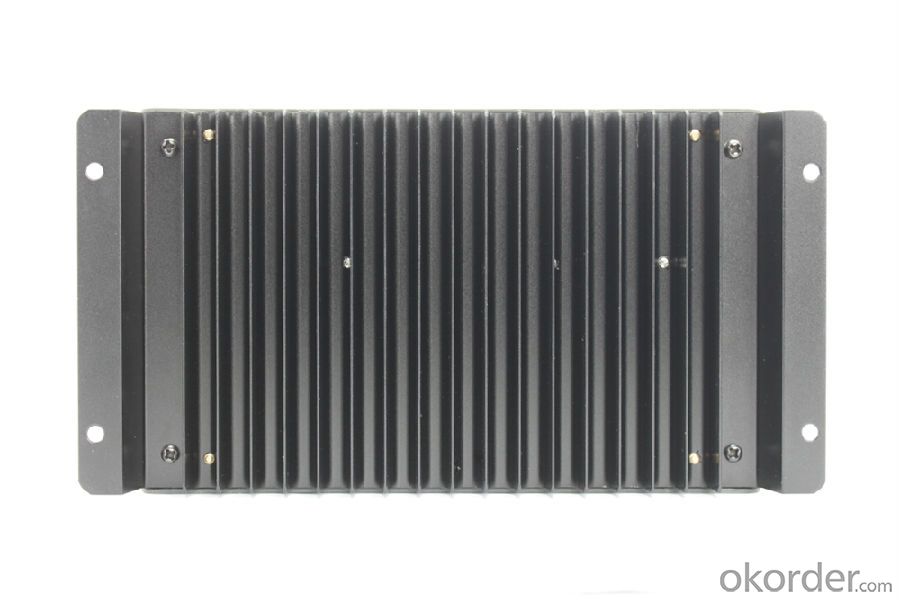
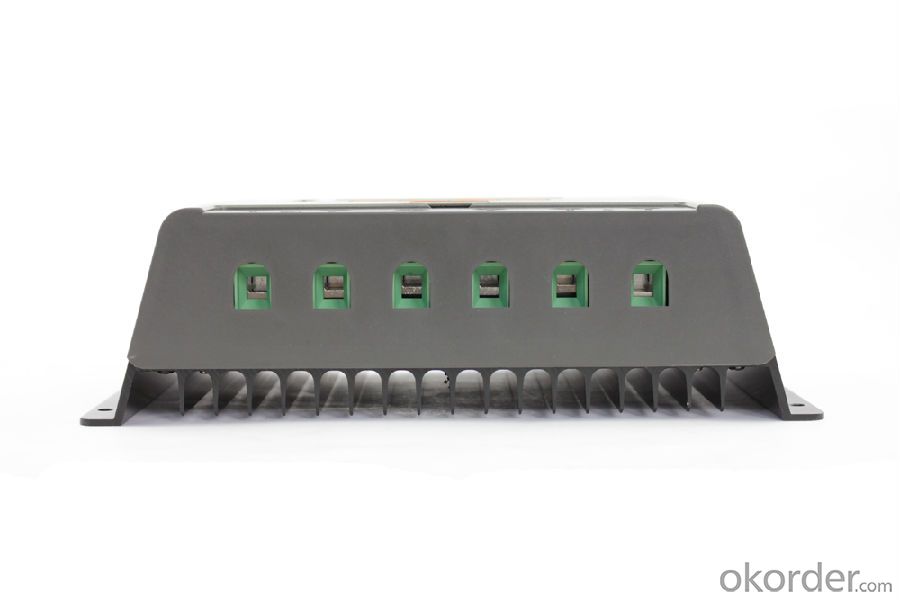
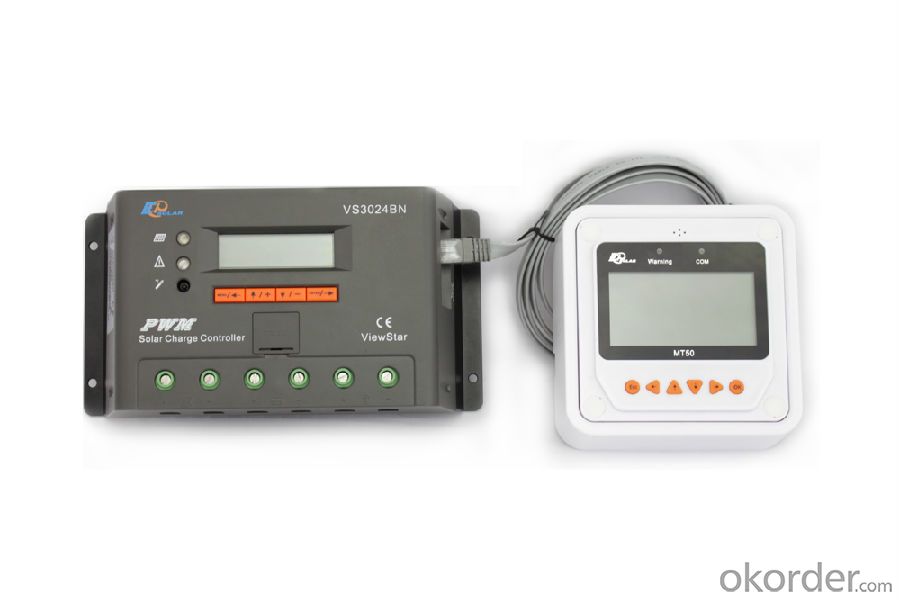
FAQ:
Q1. What is the voltage?
A1. Our 45/60A solar charge controller is 12/24/36/48V auto work.
Q2. What is the difference between MPPT&PWM?
A2. MPPT has higher efficiency, it can track the max power point and won't waste energy.
Q3. What is the efficiency of the MPPT controller?
A3. MPPT>99%, peak conversion efficiency>98%.
Q4. What is the waranty of product?
A4. 12 months.
Q5. What protection does your MPPT controller have?
A5. PV array short circuit, PV reverse polarity, Battery reverse polarity, Over charging, Output short circuit
- Q: What is the maximum load power consumption for a solar controller?
- The maximum load power consumption for a solar controller can vary depending on the specific model and specifications. However, in general, the maximum load power consumption for a solar controller is typically rated at around 10-30 amps or 120-360 watts. It is important to refer to the manufacturer's guidelines and specifications for accurate information regarding a particular solar controller's maximum load power consumption.
- Q: Are there any disadvantages of using a solar controller?
- Using a solar controller has its drawbacks. Firstly, the cost of purchasing and installing a solar controller can be quite high. This can increase the overall expenses of setting up a solar power system, which might discourage certain individuals or businesses. Secondly, operating and maintaining solar controllers can be complex. They require proper programming and configuration to ensure optimal performance, as well as regular maintenance to keep them running efficiently. This may necessitate technical expertise or the hiring of professionals, resulting in additional costs. Furthermore, solar controllers may have limited compatibility with specific solar panels or battery systems. It is crucial to ensure that the solar controller is compatible with the particular components of the solar power system. Otherwise, it may malfunction or even cause damage. Lastly, solar controllers rely on sunlight for power generation. Therefore, they may not be as effective in areas with limited sunlight or during cloudy days. This can lead to decreased energy production and may require alternative power sources or energy storage solutions. In conclusion, while solar controllers offer various advantages in terms of regulating and optimizing solar power systems, they also come with certain disadvantages that should be taken into account before making a decision.
- Q: How does a solar controller prevent battery over-discharge?
- A solar controller prevents battery over-discharge by monitoring the battery voltage and disconnecting the load from the battery when it reaches a certain low voltage threshold. This ensures that the battery is not drained beyond its safe operating level, preventing damage and prolonging the battery's lifespan.
- Q: What is the maximum current capacity of a solar controller?
- The maximum current capacity of a solar controller can vary depending on its specifications and model. However, in general, solar controllers are available in a range of current capacities, typically ranging from 10 amps to 60 amps or even higher for larger systems.
- Q: Can a solar controller handle fluctuating solar panel output?
- Yes, a solar controller is designed to handle fluctuating solar panel output. It regulates the power flow from the panels to the batteries, ensuring a consistent and stable charge. The controller adjusts the charging current based on the panel's output, optimizing the charging process and protecting the batteries from overcharging or undercharging.
- Q: How does a solar controller protect against lightning strikes?
- A solar controller protects against lightning strikes by diverting the high voltage surge caused by a lightning strike to the ground, preventing it from damaging the solar system components.
- Q: What is the maximum charging voltage a solar controller can provide?
- The maximum charging voltage a solar controller can provide is typically around 14.4 to 14.6 volts for 12-volt systems and 28.8 to 29.2 volts for 24-volt systems.
- Q: How does a solar controller handle lightning strikes or power surges?
- A solar controller is designed to protect the solar panel system from lightning strikes or power surges. It typically has built-in protection mechanisms to handle these situations. During a lightning strike or power surge, the solar controller will detect the sudden increase in voltage and current and activate its protective features. One of the main components that handle these events is the surge protector or transient voltage suppressor. This device is designed to divert the excess voltage and current away from the solar controller and the rest of the system. Additionally, the solar controller may have fuses or circuit breakers that will trip or blow in the event of a power surge or lightning strike. These protective devices are designed to interrupt the flow of electricity and prevent damage to the solar controller and other connected components. Furthermore, some solar controllers have built-in grounding mechanisms to dissipate the excess energy caused by lightning strikes. This grounding system helps to divert the energy safely into the ground, protecting the solar panel system from damage. It is important to note that while solar controllers have protective measures in place, they may not be able to completely eliminate the risk of damage from a direct lightning strike. In such cases, additional surge protection devices, like lightning arrestors or lightning rods, may be required to ensure the safety of the solar panel system. Overall, a solar controller is designed to handle lightning strikes or power surges by diverting excess energy, tripping fuses or circuit breakers, and utilizing grounding mechanisms to protect the system from damage.
- Q: Solar controller use
- The role of the controller is used to protect the battery from overdischarge. Cloudy charge current is small when there is no boost function
- Q: Can a solar controller be used with solar-powered weather monitoring stations?
- Yes, a solar controller can be used with solar-powered weather monitoring stations. A solar controller helps regulate the charging and discharging of batteries in solar-powered systems, ensuring optimal performance and protection against overcharging or deep discharging. This is particularly important for weather monitoring stations that rely on solar power to operate efficiently and reliably. The solar controller helps maintain the battery's state of charge and ensures the station's continuous operation even during periods of limited sunlight.
Send your message to us
Rv Solar Controllers - LCD/LED High Quality PWM Solar Panel Charge Controller/Regulator with CE ROHS, 30A 12V/24V, VS3024BN
OKorder Service Pledge
OKorder Financial Service
Similar products
Hot products
Hot Searches
Related keywords
